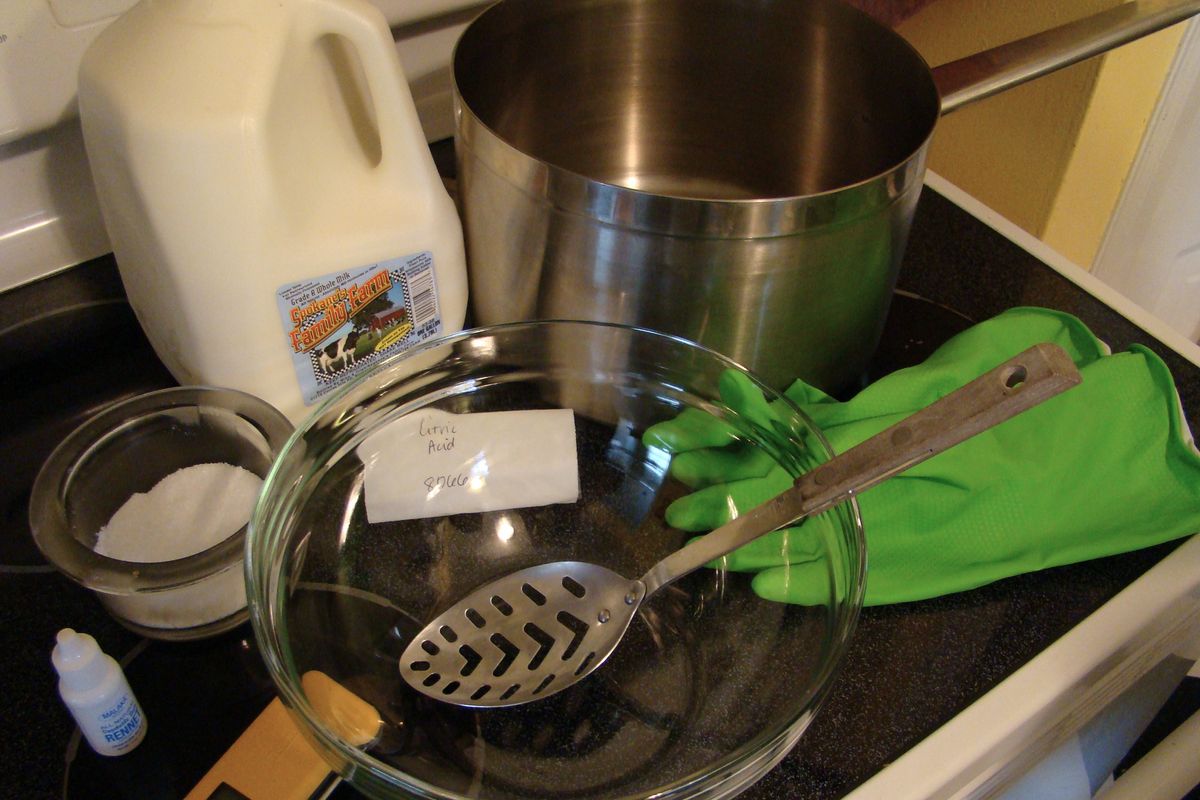Mozzarella—March Urban Farm Challenge #2

Because I have made cultured butter before, I didn’t think cultured butter was quite enough to live up to the Urban Farm Challenge; I wanted to do something new. I had read about making cheese prior to this month’s challenge, but never took on the task. It turns out that mozzarella really is the place to start if you’re undertaking homemade cheese.
I didn’t believe the blog posts and books I read before starting this project—that mozzarella only takes 30 minutes to make at home—it seemed too easy. It is that easy, though I took about 45 minutes, 15 of which was spent waiting for milk to heat with only occasional stirring, and another 20 was letting the warmed milk and rennet sit and curdle. This is not a time-consuming or difficult process. Other cheeses can take more time and careful hands-on work, but soft cheese, especially mozzarella, is quite simple.
Before starting on this project, I consulted two books (available at the Spokane Public Library) Home Dairy by Ashley English, and Home Cheese Making by Ricki Carroll. Between those recipes and the post by Jennie Grant on Sustainable Eats, I felt I had a pretty good idea of what I was getting myself into. From all three recipes, I came up with a plan.
My plan started with a search for ingredients. The key to making cheese is starting with the right milk. You need milk that is either raw (straight from the cow without any processing), or milk that has only been lightly pasteurized; ultra-pasteurized milk that we find in most grocery stores will not turn into cheese. In pasteurization, the milk is heated and held at temperatures to kill off bacteria and microorganisms—both good and bad—and also increase the shelf-life of the product. To create cheese curds, milk needs some of those microorganisms, plus some additional enzymes and a good pH balance. In every recipe I read, the authors note that if your cheese making doesn’t work, the culprit is most likely the milk. Spokane’s Family Farm milk worked like a charm for me.
You’ll also need citric acid to increase the acid content of the milk so that the enzymes can do their work. I found citric acid in the bulk spice section of Huckleberry's.
Rennet is the other essential ingredient. Rennet is an enzyme (actually many enzymes) that separate the milk into curds and whey. Rennet can be an animal or vegetable product, so check your packaging if you’re looking for vegetable rennet. You can also find rennet in liquid or tablet form. I found both at Main Market downtown. I chose vegetable-based liquid rennet and had no issues with it. Sun People Dry Goods does have cheese kits in stock if you're interested in more cheese making projects, though I didn't find individual cultures in stock.
The Sustainable Eats article also listed short-range pH test strips as necessary equipment, but in reading English and Carroll, the authors didn’t seem overly concerned with testing pH. I was also fairly confident the milk I purchased would work of the recipe, so I left the test strips off of my shopping list.
Here’s how I made mozzarella in my kitchen.
You will need:
- a gallon of whole milk (NOT ultra-pasteurized)
- 2 tsp. citric acid
- ½ tsp liquid rennet or ¼ rennet tablet
- salt
- a stainless steel stockpot
- slotted metal spoon
- measuring spoons
- instant read thermometer
- glass measuring cup
- colander
- cheesecloth
- glass bowl
- rubber gloves
- Pour the milk into a stockpot and add two teaspoons of citric acid. Stir to combine. Gently heat the milk to 90 degrees on medium-low heat.
- Dissolve the rennet (whether liquid or a tablet) in ¼ cup of cold water, then slowly pour into the warmed milk, mixing with a slow up and down motion. The curd will start forming very quickly.
- Continue to heat the milk to between 102 and 106 degrees. This only takes a few minutes. You’ll see the milk change form at this point—see the photos. When you see a solid mass of curd start to form, remove the milk from the heat, cover, and let sit for 15-20 minutes.
- When time is up, use the slotted spoon to scoop out the curds and place them in a cheesecloth-lined strainer. You want to remove as much whey as possible without breaking the curds; gently lifting the curds with a spoon into the colander worked well for me, and cut out the step of cutting the curds detailed in some of the recipes.
- When it seems most of the whey has drained, place the curds in a glass, microwaveable bowl. Microwave on high for 1 minute; this will melt the curds slightly and start bringing them together.
- Now you’ll need clean rubber gloves for kneading or pulling the curds. Gently move the curds around to distribute the heat, then pick them up and try folding and stretching them; fold them back together and stretch again. If the curds aren’t stretching, microwave again for 20 seconds and give it another try. This is also the step where you’ll add a few good pinches of salt. I actually forgot this step, and wish I hadn’t. A little salt enhances the flavor greatly.
- The mozzarella is done when it is smooth and shiny. Cut the curds apart with scissors and form into balls. Eat right away or store in the fridge.
- We made pizza with one of our chunks of mozzarella, the others I stored in the fridge in a jar with leftover whey to keep them from drying out. We’ll be using them up in the next week or two.
I may not make mozzarella every time I need some, but I think I will try it again, especially when tomatoes are ripe this summer. The process was easy and satisfying. We made a pizza the night we made cheese and it was delicious! (Next time I will remember the salt).
